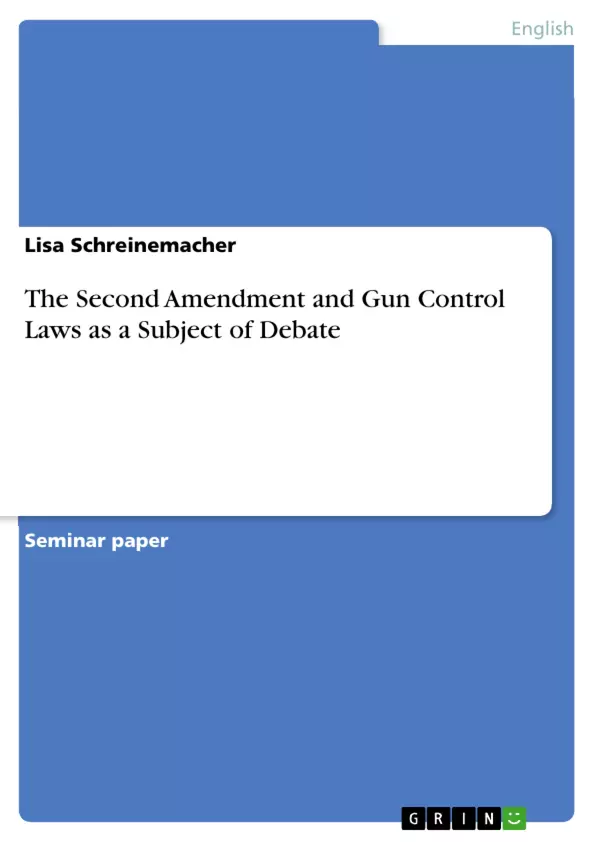This study is concerned with the historical development of the Second Amendment and how it is interpreted today.
In doing so, John Vile's "A Companion to the United States Constitution and its Amendments" and Adam Winkler's "Gun Fight" have been consulted to provide background information on the history of the Second Amendment. Due to the fact that this term paper also deals with current statistics on gun control laws, it also relied on online research and online publications.
Firstly, there will be a chapter that deals with the original intent of the founding fathers, who framed the Second Amendment to the United States Constitution. It will provide an historical overview of the creation of the Second Amendment and what led to its inclusion into the Bill of Rights. It further tries to explain the founder's interpretation of the Second Amendment with regards to the militia.
The third chapter will focus on the question of how the National Rifle Association was able to rewrite the Second Amendment in order to gain more profit and get support for gun rights. The chapter will present the approach taken by the NRA that resulted in a new interpretation of the Second Amendment and established the perception of an individual right to possess firearms within American society.
It will take into account the Supreme Court cases of "United States v. Miller" of 1939 and "District of Columbia v. Heller" of 2008, that ultimately guaranteed an individual's right to own firearms without any connection to a militia. Another chapter will focus on gun control laws and provide a comparison between the United States and other developed countries.
Furthermore, this chapter will give an insight into the perception of the Second Amendment within American society and discusses current gun control policies. Finally, the last paragraph of this term paper will be a conclusion, which sums up the results achieved and gives an outlook for future research on the Second Amendment and gun control laws.
Table of Contents
- Introduction
- The Founders' Vision of the Second Amendment
- How the NRA rewrote the Second Amendment
- Supreme Court Cases
- Gun Control Laws
- Conclusion
Objectives and Key Themes
This term paper explores the historical development and contemporary interpretations of the Second Amendment to the United States Constitution, focusing on the debate surrounding gun rights and gun control laws. The paper examines the original intent of the Founding Fathers in framing the Second Amendment, specifically its connection to the militia and safeguarding against tyranny. It further analyzes how the National Rifle Association (NRA) has influenced the interpretation of the Second Amendment, culminating in the recognition of an individual right to own firearms for self-defense. Additionally, the paper compares gun control laws in the United States to those in other developed countries and explores the contemporary landscape of gun control policies.
- Historical development of the Second Amendment
- The Founding Fathers' vision of the Second Amendment and its relationship to the militia
- The NRA's influence on the interpretation of the Second Amendment
- The role of Supreme Court cases in shaping Second Amendment jurisprudence
- A comparative analysis of gun control laws in the United States and other developed countries
Chapter Summaries
- Introduction: The introductory chapter sets the stage for the paper by outlining the ongoing debate surrounding the Second Amendment and its relevance in contemporary society. It highlights the significance of the Supreme Court's decision in District of Columbia v. Heller, which recognized an individual right to own firearms for self-defense. This chapter also provides an overview of the sources and research methodology used in the paper.
- The Founders' Vision of the Second Amendment: This chapter delves into the historical context surrounding the drafting of the Second Amendment, emphasizing the tension between the British Crown and the American colonies. It explores the role of the militia in the Founding Fathers' vision of a free and independent nation, particularly as a safeguard against government tyranny.
- How the NRA rewrote the Second Amendment: This chapter examines the influential role of the National Rifle Association (NRA) in shaping the interpretation of the Second Amendment. It discusses how the NRA's advocacy for gun rights has contributed to the perception of an individual right to own firearms for self-defense. The chapter also analyzes the impact of key Supreme Court cases, such as United States v. Miller and District of Columbia v. Heller, on the interpretation of the Second Amendment.
- Gun Control Laws: This chapter explores the current landscape of gun control laws in the United States, offering a comparison with other developed countries. It investigates the impact of various gun control policies on gun violence and examines the public perception of the Second Amendment in American society.
Keywords
This term paper explores the Second Amendment, focusing on its historical development, contemporary interpretations, and the ongoing debate surrounding gun rights and gun control. Key terms include: gun control, Second Amendment, militia, individual rights, self-defense, NRA, Supreme Court, District of Columbia v. Heller, United States v. Miller, gun violence, and comparative analysis.
- Citation du texte
- Lisa Schreinemacher (Auteur), 2019, The Second Amendment and Gun Control Laws as a Subject of Debate, Munich, GRIN Verlag, https://www.grin.com/document/496139



